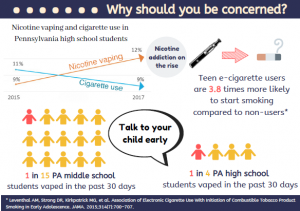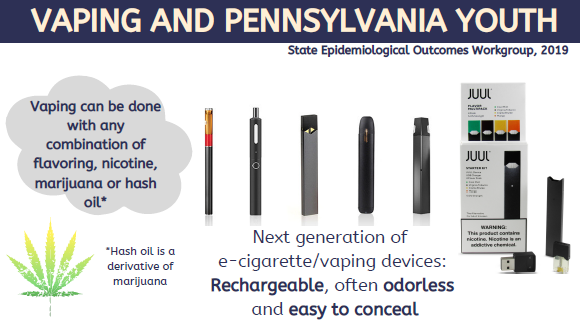Safer Is Not Safe…
If you’ve been around any large group of young people within the last couple of years, there is a chance that you’ve noticed a new trend that has emerged. No, we are not talking about their use of new and inventive language or Snapchat filters. We’re talking about Vaping. Vaping has become a serious health risk for young people and adults alike.

Though cigarette usage has been on the decline in the state of Pennsylvania, the increase in nicotine vaping has dramatically increased in the past few years. And this isn’t just a high school problem. Students as young as fourth grade have been caught with vaping paraphernalia in schools in our county!
Vaping devices go by many names: E-Cigs, Vapes, Hookah Pens, and the most popular, Juuls. No matter the name, all these devices do essentially the same thing. And all have the same health risks. The device heats up an e-liquid that usually contains nicotine and many other harmful chemicals. Once heated, the liquid turns into an aerosol that is inhaled just like a traditional combustible cigarette. The aerosol usually has little to no smell and these devices can be easily hidden to allow discrete usage. One of the scariest things about this trend is that it isn’t just nicotine that can be used in e-cigs. It’s become popular for some to use marijuana, hash oil, and even more lethal drugs such as cocaine in vaping devices.
The Vape Epidemic has become one of the most talked about topics among parents and schools. Vaping has become part of youth culture in the same way that cigarettes were part of the culture for those who grew up during the mid 20th century. It isn’t uncommon to see young people walking up the street using a vape product, or to see young drivers pull up to a red light and release a large cloud of “cotton” out of their car windows. In fact, according to a 2017 state survey of 6th, 8th, 10th, and 12th graders, more than 16% of students in our county had vaped in the last thirty days. Unfortunately, we expect this number will rise in the 2019 survey since usage among high school students has increased 78% nationally in the last year.
So what’s so bad about vaping? It’s only water vapor right?
WRONG. There are dozens of chemicals in the e-liquids used for vaping. Most of these chemicals are also in traditional cigarettes. Chemicals such as formaldehyde, metals, and acrolein – a weed killer that causes irreversible lung damage, are all present. Diacetyl, a liquid used to create flavors, and propylene glycol, which is used to make polyester and in the paint and plastic industry, are also prevalent in e-liquids. Both diacetyl and propylene glycol have been linked to Popcorn Lung, an irreversible disease that causes the smallest airways within the lungs (bronchioles) to become scarred, and reduces their capacity and efficiency.
There have also been many cases of Wet Lung found among users of vape products. When the aerosol is inhaled into the lungs, it begins to condense on the walls of the lungs. Once it turns back to liquid it becomes heavy and falls down to the bottom of the lungs. The water, along with all of the other chemicals introduced from the e-liquid, pool in this area. The lungs have a limited ability to absorb this liquid and eventually becomes unable to clear it. Wet lung makes it hard to breathe and produces a chronic, wet cough. In some severe cases it has grown into and auto-immune disorder, which finds the body attacking its own lung tissue in order to clear out this harmful intruder.
So what can be done?
One of the most important things that can be done, is to talk to your children or other young people in your life about the risks of vaping. These products have been purposely marketed towards the pre-teen and teen generation. This epidemic is no mistake. It was created by Big Tobacco companies to addict a new generation to nicotine. It is now an uphill battle that parents, educators, and the FDA, have to fight. The proper education has to start at home, or our students will receive the wrong education from their friends and classmates.
If you are a parent, Take Action to protect your child or check out The Vape Talk from the American Lung Association.
Are you a student between 12 and 18? Head over to TRU and partner with other students in our county and state to fight the vaping epidemic.
There are many ways to help both adults and students caught in the epidemic. The cessation programs are meeting people where they are at with help through quitlines, texting programs, interactive online programs, clinics, and apps!
For Teens:
Smokefree Teen – Smokefree Teen is a free, web-based program designed and run by the National Cancer Institute to help you understand the decisions you make – especially the decision to quit smoking- and how those decisions fit into your life.
Smokefree TXT – Smokefree TXT is a mobile text messaging program that provides 24/7 tips, advice, and encouragement to help you quit smoking. To sign up for Smokefree TXT simply text QUIT to IQUIT (47848). This free program is designed and run by the National Cancer Institute.
1-800-Quit-Now – The quitline is a free service that offers one-on-one immediate support. It is staffed by quit smoking coaches who can provide you with helpful information, advice and support as they walk you through a step by step plan to quit. To sign up call 1-800-QUIT-NOW (1-800-784-8669). For Spanish speakers call 1-855-Dejelo-Ya (1-855-335-3569)
QuitSTART App – QuitSTART is a free app made for teens who want to quit smoking. This app takes the information you provide about your smoking history and gives you tailored tips, inspiration, and challenges to help you become smokefree and life a healthier life. This app is free for download on iTunes and Android. This free program is designed and run by the National Cancer Institute. For more information visit www.teen.smokefree.gov.
For Adults:
Freedom From Smoking – FFS includes multiple ways to help you quit. There are clinics that you can attend, an interactive online program, and a self-help manual.
1-800-Quit-Now – The quitline is a free service that offers one-on-one immediate support. It is staffed by quit smoking coaches who can provide you with helpful information, advice and support as they walk you through a step by step plan to quit. To sign up call 1-800-QUIT-NOW (1-800-784-8669). For Spanish speakers, call 1-855-Dejelo-Ya (1-855-335-3569)





